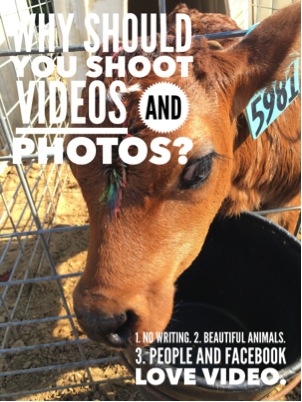
In my last blog post, “Social media is a farmer's friend," I explained why it was important that you engage your consumers through social media. I laid out three simple things you need to start:
1. Create a farm website.
2. Create a Facebook Farm Page.
Why should you have a website? A website is important because you need to have something online that will represent your farm 24/7. It should be as simple and as beautiful as your farm. Another reason is that you don’t want your online farm showcase to be sitting on rented ground like a Facebook Page or Instagram business page. For instance, your Facebook profile and pages are not owned by you, and without your control they can change the way you interact with your followers.
You can easily build a website these days using systems like Wordpress, Square Space, Weebly or Wix. They don’t cost what they used to and are definitely easier to control.
On the homepage, you should put some pictures of the farm and your animals. Visitors should know it’s a farm website by looking at the page for five seconds.
For the navigation of the website, you should start with basic sections. Each section answers a different set of questions that you would get from a consumer.
About us — This section should answer “Why do you farm?” and “Can you tell me the history of your farm?”
Our cows — Here you should answer all the questions you get about the cows like “What do cows eat?” and “How does a cow make milk?”
Our products — This part of the website should explain “Where does your milk go?” and “Where can I buy it?”
Tours — This section should answer the question, “Can I visit the farm?” Even if they can’t, you should have a visual tour of the farm through photos or videos explaining all the aspects of your farm.
Contact us — This page should let people know “Who can I reach out to about the farm?” and make sure it connects with your social media channels like your Facebook Farm Page.
Once you have the website done, you won’t have to update it too often as long as it contains the latest changes to your farm.
Why should you have a Facebook Farm Page? Facebook is about four times as large as all the other social media platforms. It is by far the most active, and consumers are spending a lot of time on it. It also gives you direct access to them and a way to communicate in real time, which isn’t available on most websites.
If you have a Facebook Profile, you can build a Facebook Farm page. Here’s a link to the steps on how to set one up.
Once the Facebook Page is set up, almost everything you do can be handled by your smartphone. You’ll want to download the Facebook Page app for easier access to your Facebook Farm Page.
Why should you shoot video and photos of the farm and share them? The first benefit it if you share photos or videos, you don’t have to write very much. I hear from many farmers that they find writing painful to do. You’ll also be happy to hear that most people love videos and photos more than reading. Videos and photos are much easier to do because all you have to do is point your smartphone and shoot.
Second, you have beautiful subjects: the farm, the animals and the lifestyle. Consumers want to see it - not just read about it. The number one thing that people love to look at is calves. If you are looking for other examples of what you should be posting online, you can check that out on my post “What should you be posting on your Facebook Farm Page”.
Third, Facebook tends to prioritize photos and videos on people’s newsfeed. In other words, this is why when you visit Facebook you see a lot more video and photos. Take three or four minutes every couple of days, post a quick video and then write up what is happening on the farm.
Fourth, by using Facebook you are actually building a digital diary of your farm that your great-great-grandkids will go check out long after we are all gone. Digital content never goes away so they’ll be able to see what your life was like on the farm. What a great gift to the future.
If you’ve got more than just a few minutes and you really want to connect with your younger consumers, then add more channels like YouTube and Instagram.
Finally, once you get comfortable sharing your story, I’m sure you’d be interested in sharing stories about the dairy industry. That’s why your National Dairy Checkoff staff created a mobile and web application that allows you to quickly see and share positive dairy stories from anywhere. With only one click, you can share these stories to your social media channels. The app is called the Dairy Hub Amplification Center and you can join it by filling out this form. http://bit.ly/dairyampcenter
If you have any questions about social media, the internet or communicating with consumers, feel free to reach out to me at don.schindler@dairy.org or you can reach me on social via Facebook, Twitter or Instagram. I would be happy to help you.
The author is a Senior Vice President of Digital Initiatives at Dairy Management Inc.








